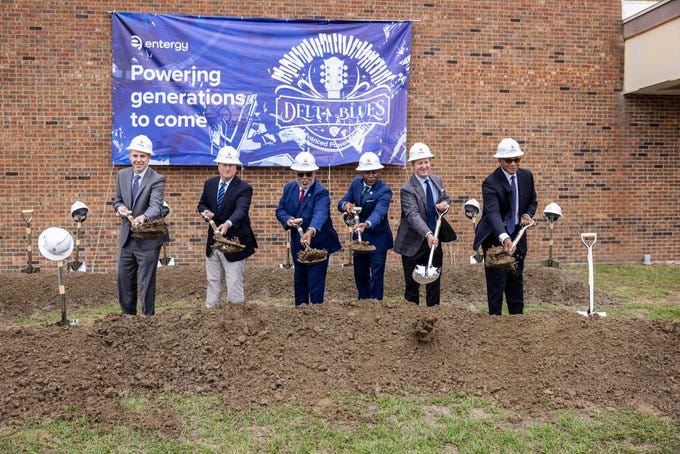Entergy's Natural Gas Plants Potentially Changing the Future of How Data Centers are Powered
A new way to look at gas: a reliable and sustainable energy source
Entergy (NYSE: ETR), the integrated power utility, has recently applied with the Louisiana Public Service Commission (LPSC) to construct three new Combined Cycle Gas Turbine (CCGT) plants, totaling 2.3 gigawatts (GW) of power to support a “significant customer project” in North Louisiana (see public filing here). Given the AI boom, people are speculating whether it’s for data centers.
Source: A different project by Entergy - https://x.com/EntergyMS/status/1854629904135991495
This ambitious initiative involves an investment exceeding $5 billion from the mysterious customer. It is expected to create between 300 and 500 jobs, providing a much-needed economic boost to a region historically struggling with high rates of low-income households, low employment figures, and limited industrial development.
Mystery Customer??
So, who is this mysterious customer that will transform Louisiana's local economy? If it is indeed a data center, it would set an example of how data centers can be powered by natural gas. While the customer’s identity remains confidential in the filing, analysis of the load profile strongly suggests that it is a hyper-scale data center - could it be Meta? Microsoft? Or even Alibaba? Tencent? ByteDance? (SHOCK SHOCK *Scandallll*) JK IT WAS REVEALED TO BE META.
Sidetrack rant: The reason I suspect it’s one of the big Chinese tech companies is that they obviously cannot build data centers in China right now for their US/international business, given all the concerns over data security from the US. But why wouldn't they disclose their name if it’s just another US big tech hyperscaler? It’s not like Meta, Google, or Microsoft have been hiding their names in other deals (nothing to hide, right?) - I thought about filing a FOIA but didn’t think it was THAT important to figure out who is behind it, really, right?
Anyway, no matter who is behind this deal, if it goes through. This would significantly shift how data centers secure their energy needs. Previously, tech giants like Amazon, Microsoft, and Google have mostly considered relying on nuclear power sources to power their data centers. Notable announcements include the power deal between Amazon and Talen’s nuclear power plant (which FERC recently rejected; I wrote about it here), the restart of the Three Miles Island nuclear power plant by Microsoft, and various SMR deals announced by Google (which I also wrote about here).
However, the capacity of existing nuclear power is very limited in the U.S. (and a recent FERC ruling indicates that the capacity is pretty much “off-limits”), and building new nuclear power can take a very long time. The latest Entergy project highlights a growing trend toward considering or preferring natural gas as a viable alternative, especially when paired with additional renewable and carbon capture investments.
It shows that the industry heard the regulator’s clear intentions - DO NOT BUY EXISTING plants (we’ll block the deals), but building NEW ONES is A-okay (we need more capacity!!).
Overview of the Entergy Project
Let’s take a closer look at the Entergy project:
The project contains three combined-cycle gas turbines (CCGT generators); each generator will have a capacity of 754 megawatts (MW), bringing the total to a whopping 2,262 MW.
Two generators will be situated near the customer's site in Holly Ridge, while the third will be in Southeast Louisiana.
All generators will be designed to co-fire with up to 30% hydrogen and can be upgraded for 100% hydrogen firing in the future.
The project also includes future carbon capture technology provisions, aligning with global sustainability goals.
The unnamed customer has also committed to investing an additional 1.5 GW of solar and storage capacity and will fund carbon capture at one of Entergy's existing CCGT plants. This commitment underscores this customer's ESG commitment.
Natural Gas: An Essential Transition Fuel
The Entergy deal represents a pivotal moment in energy sourcing for data centers (I wrote about why we can’t entirely rely on renewables yet here and explained the importance of gas as a power source). Natural gas has historically been viewed as less environmentally friendly than renewables or nuclear energy, but it is now recognized as a crucial transitional fuel.
As ITIF’s Robin Gaster wrote for RealClearEnergy, “We have to understand that in the United States, gas will be a critical enabler of wind and solar, providing the grid with the reliability that wind and solar alone cannot.”
I’ve also heard from experts who say choosing natural gas as a transition fuel is suitable for carbon reduction and much better for the environment. (Consider the pollution from burning coal, e.g., the Beijing haze/severe pollution issue in northern China.) Gas has proven to be consistently reliable and cost-competitive.
Reliability & dispatchability: Natural gas provides a stable and reliable power source essential for data centers, which require uninterrupted electricity for their operations.
Lower emissions: Compared to coal and oil, natural gas emits significantly less CO2 when burned, making it a cleaner option during this transitional phase toward fully renewable energy sources.
Economic viability: Natural gas's lower cost compared to other fossil fuels makes it an attractive option for large-scale power generation needed by data centers.
The Bottom Line
The Entergy project is more than just an infrastructure investment; it signifies a shift in how hyper-scale data centers approach their energy needs. Investors and policymakers have been fixated on renewable energy (companies). Still, natural gas may become a more likely fix to the US power shortage problem, especially under the new Trump administration.
By leveraging natural gas alongside renewable resources, this initiative could redefine perceptions about fossil fuels in the context of environmental responsibility and economic development.
As we move further into an era of exponentially increasing digital infrastructure demands, mostly driven by trends like artificial intelligence, the role of natural gas as a reliable and (comparatively) cleaner energy source will only become more pronounced.








